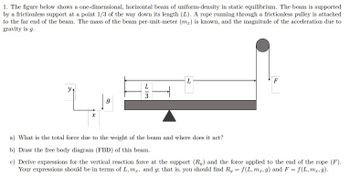
Elements Of Electromagnetics
7th Edition
ISBN: 9780190698614
Author: Sadiku, Matthew N. O.
Publisher: Oxford University Press
expand_more
expand_more
format_list_bulleted
Question

Transcribed Image Text:1. The figure below shows a one-dimensional, horizontal beam of uniform-density in static equilibrium. The beam is supported
by a frictionless support at a point 1/3 of the way down its length (L). A rope running through a frictionless pulley is attached
to the far end of the beam. The mass of the beam per-unit-meter (m) is known, and the magnitude of the acceleration due to
gravity is g.
y
| 9
13
a) What is the total force due to the weight of the beam and where does it act?
b) Draw the free body diagram (FBD) of this beam.
c) Derive expressions for the vertical reaction force at the support (R) and the force applied to the end of the rope (F).
Your expressions should be in terms of L, m,, and g; that is, you should find Ry = f(L, mr, g) and F = f(L, mz.g).
Expert Solution
This question has been solved!
Explore an expertly crafted, step-by-step solution for a thorough understanding of key concepts.
This is a popular solution
Trending nowThis is a popular solution!
Step by stepSolved in 3 steps with 3 images

Knowledge Booster
Learn more about
Need a deep-dive on the concept behind this application? Look no further. Learn more about this topic, mechanical-engineering and related others by exploring similar questions and additional content below.Similar questions
- The compound beam is pin supported at B and supported by rockers at A and C. There is a hinge (pin) at D. Suppose that w = 7.5 kN/m. a) Determine the y component of reaction at point C using scalar notation. b) Determine the y component of reaction at point A using scalar notation. c) Determine the x and y components of reaction at point B using scalar notation.arrow_forward3) Find the forces developed in beams FE, CE, and CD. State whether they're in tension or compression. A 20 № 20cm f B 4444 20cm 20cm 20cm 100 N 3 9 5 20cm с E 20cm 55Narrow_forwardA force 32 N is being applied to a beam 50 m as shovwn. Find the resulting moment vector and the magnitude of that vector. F= 32N L= 50m The moment vector is MB The moment is in the Select an answer v direction. The moment vector goes Select an answer The magnitude of the moment is (put the units in the second box).arrow_forward
- Please:arrow_forwardBrandon is trying to create a cool shelf bracket using pipes like he saw on Instagram. He is concerned about the pipe unscrewing from the wall bracket at A. He wants to know how likely it is that it will unscrew. Using some combination of drawings and written statements, answer the following questions. 1) What moment direction/axis would be critical to the pipe unscrewing at A? 2) Based on the current geometry, which force direction of F is most likely to create the moment described in part 1? 3) If the weight of the books acts only downwards, how could he modify his bracket so it cannot unscrew? You can use any combination of the parts shown (no need to use all of them). Show where the now vertical load F will be applied. Explain why your new design will be less likely to get unscrewed at A. x B 0.5 m 0.4 m A 0.3 m 0.3 marrow_forwardPlease see photo for full questionarrow_forward
- D 40.0 cg 30.0⁰ H 2.0 m draw the free body diagram. draw the vector starting at the black dogs. The location and orientation matter. A uniform, 3.0 m, 1250 kg beam is hinged to a wall and supported by a thin cable attached 2.0 m from the free end of the beam (Figure 1). The beam is supported at an angle of 30.0° above the horizontal.arrow_forward1.)Given and requirement(s) 2.)Free body diagram 3.) Formulas and its proper symbols 4.) Direction of forces and sign convention. The vertical and horizontal components must also be indicated in your free body diagram. Use three significant figures for your final answer and box it.arrow_forwardQI: Determine the reactions of the beam shown in the figure. 400N 1000N 1.2m 0.8m 0.8m.arrow_forward
- Gggarrow_forwardThe person who answered this previously used sin and cos-please use geometry for example 3,4,5 triangles things of that nature. Thanksarrow_forwardFind the Nominal force, N in kilo Newtons (kN). What is the shear force, V in kilo Newtons (kN). Find the bending moment, M in kilo Newton metres (kNm).arrow_forward
arrow_back_ios
SEE MORE QUESTIONS
arrow_forward_ios
Recommended textbooks for you
 Elements Of ElectromagneticsMechanical EngineeringISBN:9780190698614Author:Sadiku, Matthew N. O.Publisher:Oxford University Press
Elements Of ElectromagneticsMechanical EngineeringISBN:9780190698614Author:Sadiku, Matthew N. O.Publisher:Oxford University Press Mechanics of Materials (10th Edition)Mechanical EngineeringISBN:9780134319650Author:Russell C. HibbelerPublisher:PEARSON
Mechanics of Materials (10th Edition)Mechanical EngineeringISBN:9780134319650Author:Russell C. HibbelerPublisher:PEARSON Thermodynamics: An Engineering ApproachMechanical EngineeringISBN:9781259822674Author:Yunus A. Cengel Dr., Michael A. BolesPublisher:McGraw-Hill Education
Thermodynamics: An Engineering ApproachMechanical EngineeringISBN:9781259822674Author:Yunus A. Cengel Dr., Michael A. BolesPublisher:McGraw-Hill Education Control Systems EngineeringMechanical EngineeringISBN:9781118170519Author:Norman S. NisePublisher:WILEY
Control Systems EngineeringMechanical EngineeringISBN:9781118170519Author:Norman S. NisePublisher:WILEY Mechanics of Materials (MindTap Course List)Mechanical EngineeringISBN:9781337093347Author:Barry J. Goodno, James M. GerePublisher:Cengage Learning
Mechanics of Materials (MindTap Course List)Mechanical EngineeringISBN:9781337093347Author:Barry J. Goodno, James M. GerePublisher:Cengage Learning Engineering Mechanics: StaticsMechanical EngineeringISBN:9781118807330Author:James L. Meriam, L. G. Kraige, J. N. BoltonPublisher:WILEY
Engineering Mechanics: StaticsMechanical EngineeringISBN:9781118807330Author:James L. Meriam, L. G. Kraige, J. N. BoltonPublisher:WILEY

Elements Of Electromagnetics
Mechanical Engineering
ISBN:9780190698614
Author:Sadiku, Matthew N. O.
Publisher:Oxford University Press

Mechanics of Materials (10th Edition)
Mechanical Engineering
ISBN:9780134319650
Author:Russell C. Hibbeler
Publisher:PEARSON

Thermodynamics: An Engineering Approach
Mechanical Engineering
ISBN:9781259822674
Author:Yunus A. Cengel Dr., Michael A. Boles
Publisher:McGraw-Hill Education

Control Systems Engineering
Mechanical Engineering
ISBN:9781118170519
Author:Norman S. Nise
Publisher:WILEY

Mechanics of Materials (MindTap Course List)
Mechanical Engineering
ISBN:9781337093347
Author:Barry J. Goodno, James M. Gere
Publisher:Cengage Learning

Engineering Mechanics: Statics
Mechanical Engineering
ISBN:9781118807330
Author:James L. Meriam, L. G. Kraige, J. N. Bolton
Publisher:WILEY